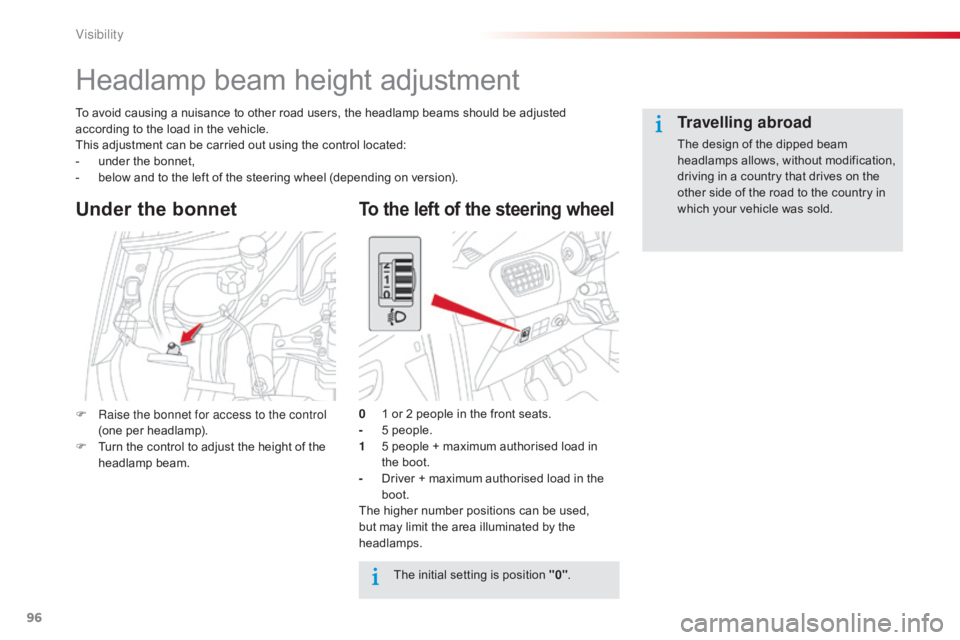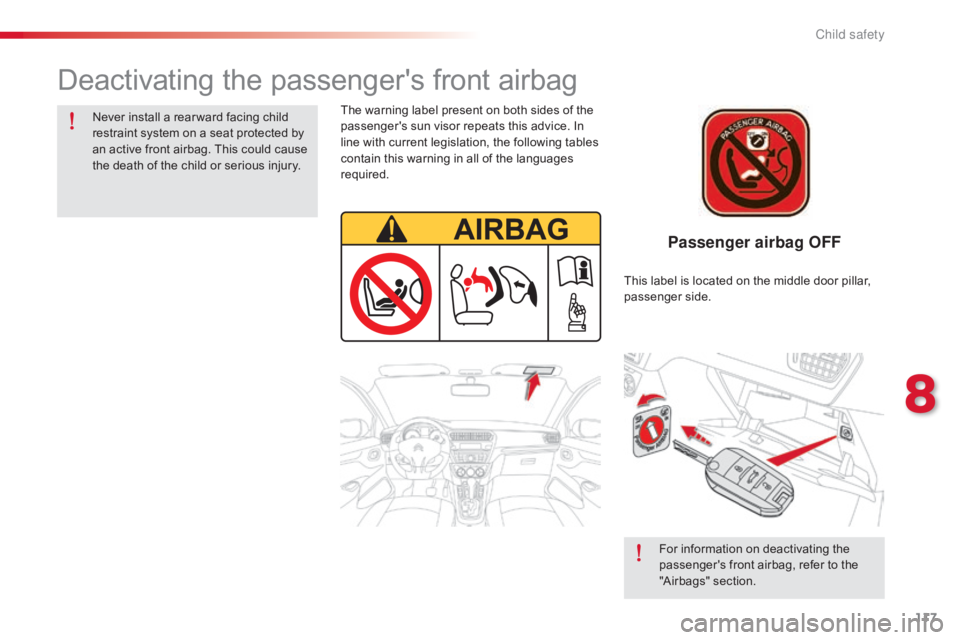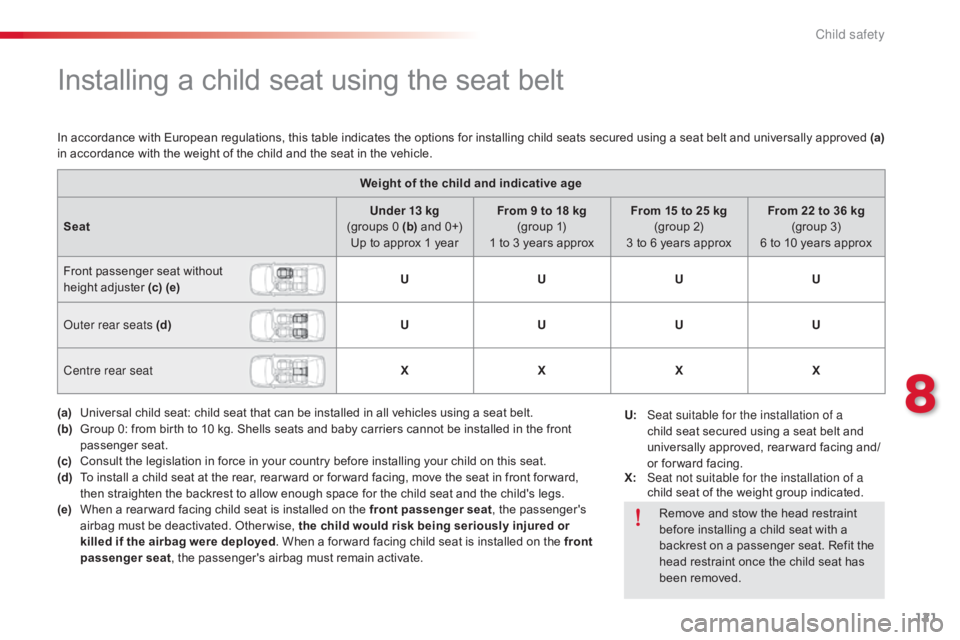2016 CITROEN C-ELYSÉE Cate
[x] Cancel search: CatePage 98 of 260

96
C-elysee_en_Chap06_visibilite_ed01-2016
Headlamp beam height adjustment
To avoid causing a nuisance to other road users, the headlamp beams should be adjusted according to the load in the vehicle.
This
adjustment can be carried out using the control located:
-
u
nder the bonnet,
-
b
elow and to the left of the steering wheel (depending on version).
The
initial setting is position "0".
0
1
or 2 people in the front seats.
-
5
people.
1
5
people + maximum authorised load in
t
he boot.
-
D
river + maximum authorised load in the
b
oot.
The
higher number positions can be used,
b
ut may limit the area illuminated by the
h
eadlamps.
Under the bonnet
F Raise the bonnet for access to the control (one per headlamp).
F
T
urn the control to adjust the height of the
h
eadlamp
b
eam.
Travelling abroad
The design of the dipped beam headlamps allows, without modification,
d
riving in a country that drives on the
o
ther side of the road to the country in
w
hich your vehicle was sold.
To the left of the steering wheel
Visibility
Page 101 of 260

99
C-elysee_en_Chap06_visibilite_ed01-2016
Courtesy lamps
In this position, the courtesy lamp c
omes on gradually:
-
w
hen
the vehicle is unlocked,
-
w
hen
the key is removed from the ignition,
-
w
hen
a door is opened,
-
w
hen
the remote control locking button is
a
ctivated, in order to locate your vehicle.
It
switches off gradually:
-
w
hen
the vehicle is locked,
-
w
hen
the ignition is switched on,
-
3
0
seconds after the last door is closed.
Permanently
off.
Permanent
l
ighting. F
W ith the ignition on, press the
c
orresponding
s
witch.
A.
C
our tesy lamps
B.
M
ap reading lamps With
the "permanent lighting" mode, the
d
uration of lighting varies, depending on
t
he
c
ircumstances:
-
w
ith the ignition off, approximately
t
en
m
inutes,
-
i
n energy economy mode,
a
pproximately thirty seconds,
-
w
ith the engine running, unlimited.
Front map reading lampsFront and rear courtesy lamps
6
V
Page 105 of 260

103
C-elysee_en_Chap07_securite_ed01-2016
Reinitialisation of the system must be done with the ignition on and the vehicle stationary:
- i n the vehicle configuration menu for vehicles fitted with a display screen,
-
u
sing the button in the glove box for vehicles without display screen.
Monochrome screen C
F Press the "7" or " 8" button to select the
" Driving assistance ",
category, then
c
onfirm by pressing the central button.
F
P
ress the " 7" or " 8", button to select " Ty r e
pressures" , then "Reinitialisation ", then
confirming
by pressing the central button.
A
message confirms the reinitialisation.
F
P
ress the MENU
button for access to the
main
menu.
F
P
ress the " 7" or " 8" button to select the
" Personalisation-configuration ",
menu
t
hen
confirm
by
pressing
the
central
button.
F
P
ress the " 7" or " 8" button to select the
" Define vehicle parameters ",
menu,
then
c
onfirm
by
pressing
the
central
button.
7
Safety
Page 106 of 260

104
C-elysee_en_Chap07_securite_ed01-2016
Vehicles without display screen
F Open the glove box.
F M ake a long press on this button.
Reinitialisation
is confirmed by an low-pitched
a
udible
s
ignal.
A
high-pitched audible signal indicates that the
r
einitialisation has not been done.
The
new pressure settings registered are
c
onsidered to be reference values by the
s
ystem.
Operating fault
The under-inflation alert is only d ependable if the system has been
r
einitialised with all four tyres inflated to
t
he correct pressures.
Snow chains
The system does not have to be reinitialised after fitting or removing
sn
ow
c
hains. Before
doing anything to the system,
t
he pressures of the four tyres must be
c
hecked and the system reinitialised.
The
flashing and then fixed illumination of the
u
nder-inflation
w
arning
lam
p
a
ccompanied
b
y illumination of the Service warning lamp
i
ndicates a fault with the system.
In this case, under-inflation monitoring of the t
yres is no longer assured.
Have the system checked by a CITROËN
d
ealer or a qualified workshop.
S
Page 107 of 260

105
C-elysee_en_Chap07_securite_ed01-2016
Group of supplementary systems which help you to obtain optimum braking in complete
s
afety in emergency situations:
-
a
nti-lock braking system (ABS),
-
e
lectronic brake force distribution (EBFD),
-
e
mergency braking assistance (EBA).
Braking assistance systems
Anti-lock braking system
and electronic brake force
distribution
Linked systems which improve the stability and manoeuvrability of your vehicle when braking,
i
n particular on poor or slippery sur faces.
Activation
The anti-lock braking system comes into operation automatically when there is a risk of
w
heel lock.
Normal
operation of the ABS may make itself
f
elt by slight vibration of the brake pedal.
Operating fault
Emergency braking assistance
System which, in an emergency, enables you to obtain the optimum braking pressure more
q
uickly, thus reducing the stopping distance.
When
braking in an emergency, press
f
irmly without releasing the pressure.
When
braking
in
an
emergency,
press
v
ery
firmly
without
releasing
the
p
ressure. When
replacing
wheels
(tyres
and
r
ims),
ensure
that
they
conform
to
the
ma
nufacturer's
r
ecommendations.
If
this
warning
lamp
comes
on,
a
ccompanied
by
an
audible
signal
a
nd
a
message
in
the
screen,
it
i
ndicates
a
malfunction
of
the
anti-lock
braking
s
ystem
which
could
result
in
loss
of
control
of
t
he
vehicle
when
braking.
If
this
warning
lamp
comes
on,
t
ogether
with
the
STOP
and
ABS
warning
lamps,
accompanied
by
an
a
udible
signal
and
a
message
in
the
screen,
it
i
ndicates
a
malfunction
of
the
electronic
brake
f
orce
distribution
which
could
result
in
loss
of
c
ontrol
of
the
vehicle
when
braking.
You must stop as soon as it is safe to do so.
In
either
case,
contact
a
CITROËN
dealer
or
a
q
ualified
w
orkshop.
Activation
It is triggered by the speed at which the brake p edal is pressed.
The
effect of this is a reduction in the
r
esistance of the pedal and an increase in
b
raking
e
fficiency.
Coasting
with
the
engine
off
results
in
a
l
oss
of
power
assistance
for
braking.
7
Safety
Page 108 of 260

106
C-elysee_en_Chap07_securite_ed01-2016
Anti-slip regulation (ASR)
and electronic stability
programme (ESP)
The anti-slip regulation (also known as Traction Control) optimises traction to prevent skidding o
f the wheels, by acting on the brakes of the
d
riving wheels and on the engine.
The
electronic stability programme acts on the
b
rake of one or more wheels and on the engine
t
o keep the vehicle on the trajectory required by
t
he driver, within the limits of the laws of physics.
This
is indicated by flashing of this
w
arning lamp in the instrument panel. The
ASR /ESP systems offer
e
xceptional safety in normal driving, but
t
his should not encourage the driver to
t
ake extra risks or drive at high speed.
The
correct functioning of these
s
ystems depends on observation of
t
he
ma
nufacturer's
r
ecommendations
r
egarding the wheels (tyres and rims),
t
he braking components, the electronic
c
omponents and the assembly
a
nd repair procedures used by the
C
ITROËN dealer network.
After
an impact, have these systems
c
hecked by a CITROËN dealer or a
q
ualified
w
orkshop.
Operating fault
Illumination of the warning lamp, accompanid by a message in the
s
creen indicates a malfunction of
t
hese systems.
Reactivation
These systems are reactivated automatically every time the ignition is switched of, or from
3
0 mph (50 km/h).
F
P
ress this button again to reactivate them
m
anually.
T
he lamp in the button goes off.
The
symbol going off in the instrument panel
i
ndicates the reactivation of the ASR and
ES
P systems.
Deactivation
In exceptional conditions (starting a vehicle which is bogged down, stuck in snow, on soft
g
round, ...), it may be advisable to deactivate
t
he ASR and ESP systems, so that the wheels
c
an move freely and regain grip.
Trajectory control systems
Activation
These systems are activated automatically each time the vehicle is started.
They
come into operation in the event of a grip
o
r
t
rajectory
pro
blem. The
display of this symbol indicates
t
hat the ASR and ESP systems are
d
eactivated.
F
P
ress this button button, located on
t
he dashboard (driver's side), until the
c
orresponding symbol appears in the i
nstrument panel screen. T
he lamp in the button comes on.Contact
a CITROËN dealer or a qualified
w
orkshop to have the ASR /ESP systems
c
hecked.
Coasting with the engine off results in a
l
oss of power assistance for the steering.
S
Page 119 of 260

117
C-elysee_en_Chap08_securite-enfants_ed01-2016
Passenger airbag OFF
Deactivating the passenger's front airbag
Never install a rear ward facing child restraint system on a seat protected by
a
n active front airbag. This could cause
t
he death of the child or serious injury.
For
information on deactivating the
p
assenger's front airbag, refer to the
"
Airbags" section.
The
warning label present on both sides of the p
assenger's sun visor repeats this advice. In
l
ine with current legislation, the following tables
c
ontain this warning in all of the languages
r
equired.
This
label is located on the middle door pillar,
p
assenger
s
ide.
8
Child safety
Page 123 of 260

121
C-elysee_en_Chap08_securite-enfants_ed01-2016
Installing a child seat using the seat belt
Weight of the child and indicative age
Seat Under 13 kg
(groups
0 (b)
and 0+)
Up
to approx 1 yearFrom 9 to 18 kg
(group
1)
1
to 3 years approxFrom 15 to 25 kg
(group
2)
3
to 6 years approxFrom 22 to 36 kg
(group
3)
6
to 10 years approx
Front
passenger
seat
without
h
eight
adjuster
(c) (e) U
UUU
Outer rear seats (d) UUUU
Centre rear seat XXXX
(a)
U
niversal
child
seat:
child
seat
that
can
be
installed in all vehicles using a seat belt.
(b )
G
roup
0:
from
birth
to
10
kg.
Shells
seats
and
baby
carriers cannot be installed in the front
p
assenger
sea
t.
(c )
C
onsult
the
legislation
in
force
in
your
country
before installing your child on this seat.
(d)
T
o
install
a
child
seat
at
the
rear,
rear ward
or
for ward facing, move the seat in front for ward,
t
hen
straighten
the
backrest
to
allow
enough
space
for the child seat and the child's legs.
(e)
W
hen
a
rear ward
facing
child
seat
is
installed
on
the front passenger seat ,
the passenger's
a
irbag
must
be
deactivated.
Other wise,
the child would risk being seriously injured or
killed if the airbag were deployed .
When
a
for ward facing child seat is installed on the front
passenger seat ,
the
passenger's
airbag
must
remain activate.
In
accordance
w
ith
European
r
egulations,
t
his
table
indicates
the
o
ptions
f
or
i
nstalling
child
s
eats
s
ecured
u
sing
a
seat
b
elt
and
u
niversally
approved (a)
in
accordance
with
the
weight
of
the
child
and
the
seat
in the vehicle.
Remove and stow the head restraint
b
efore installing a child seat with a
b
ackrest on a passenger seat. Refit the
h
ead restraint once the child seat has
b
een removed.
U
:
S
eat suitable for the installation of a
child
seat secured using a seat belt and
u
niversally approved, rear ward facing and/
or
for ward facing.
X:
S
eat not suitable for the installation of a
child
seat of the weight group indicated.
8
Child safety